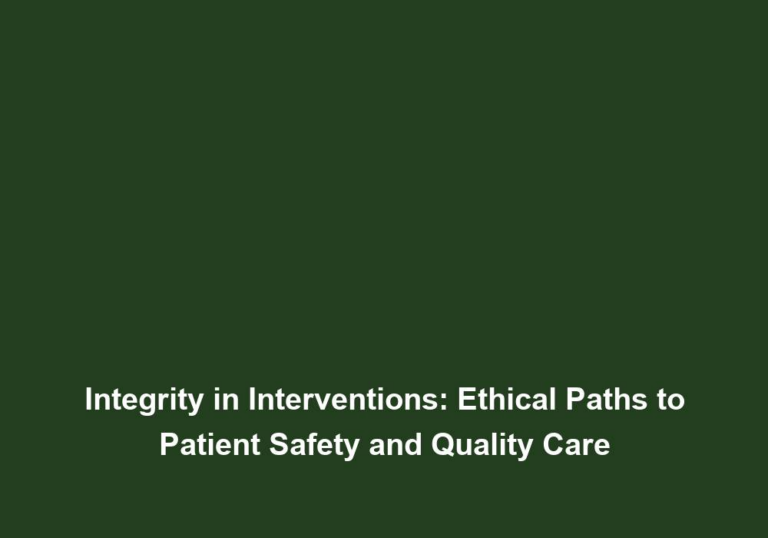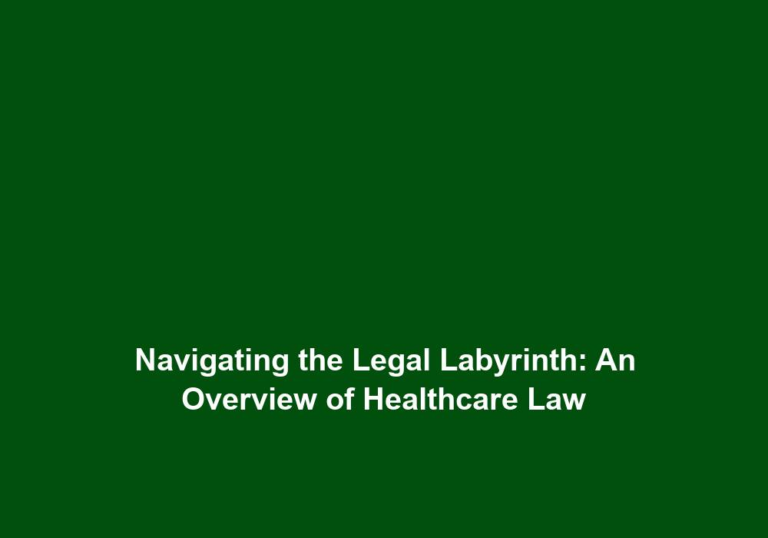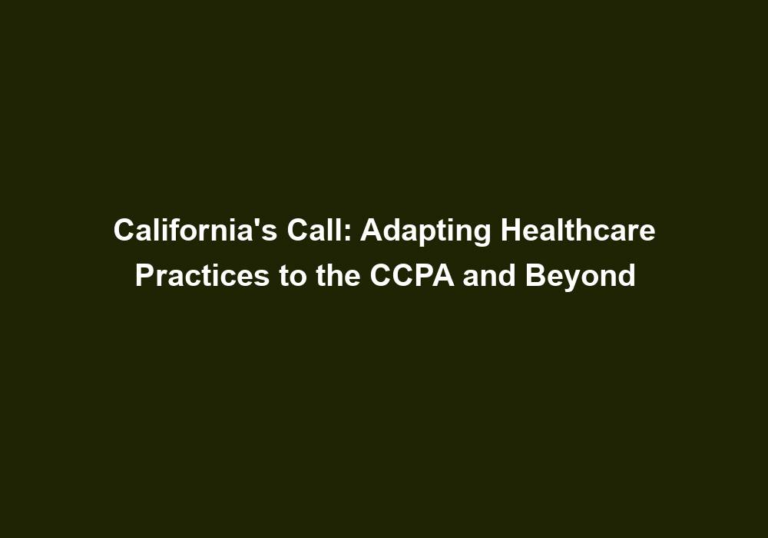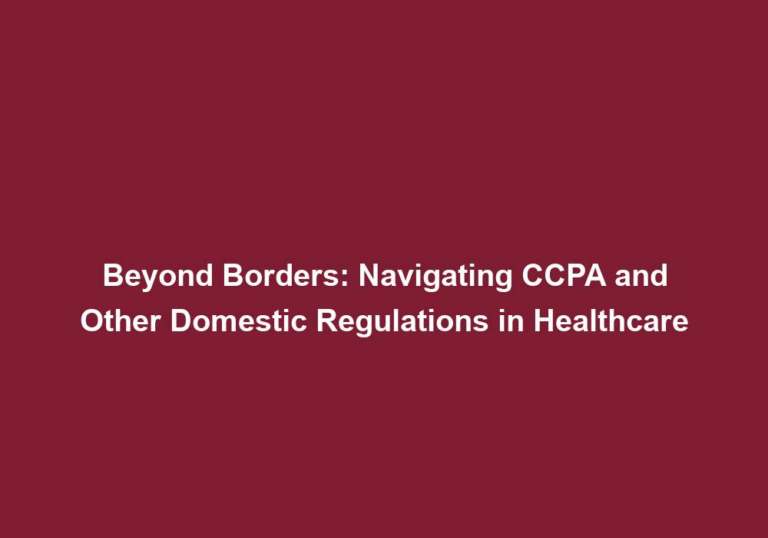The Pillars of Practice: Understanding Compliance and Regulations in Healthcare
In the ever-evolving field of healthcare, compliance and regulations play a vital role in ensuring the safety, quality, and integrity of patient care. It is crucial for healthcare professionals and organizations to have a comprehensive understanding of these pillars to maintain ethical practices and adhere to legal requirements. This article aims to shed light on the various aspects of compliance and regulations in healthcare, highlighting their significance and providing valuable insights for healthcare practitioners.
Why Compliance and Regulations Matter in Healthcare
- Patient Safety and Quality of Care: Compliance with regulations ensures that healthcare practices prioritize patient safety and maintain the highest standards of quality care. By adhering to prescribed guidelines and regulations, healthcare providers can minimize errors, reduce adverse events, and improve patient outcomes.
- Compliance with regulations helps healthcare professionals implement evidence-based practices that have been proven to enhance patient safety and improve the quality of care. This includes following established protocols for medication administration, infection control, and patient monitoring.
- It also involves implementing processes for error reporting and analysis, allowing healthcare organizations to identify systemic issues and develop strategies for improvement.
- By prioritizing compliance, healthcare professionals can create a culture of safety where patient well-being is the top priority.
- Legal Obligations and Avoidance of Penalties: Compliance with regulations is a legal obligation for healthcare professionals and organizations. Failure to comply can result in legal consequences, including fines, penalties, loss of license, or even imprisonment. By strictly following the regulations, healthcare practitioners can protect themselves and their organizations from potential legal troubles.
- Healthcare professionals must familiarize themselves with the relevant regulatory bodies and their specific requirements to ensure compliance. This includes staying up-to-date with changes in regulations and seeking appropriate legal counsel when needed.
- Compliance programs should be established within healthcare organizations to ensure that all staff members are aware of their legal obligations and trained to fulfill them.
- By proactively addressing compliance issues and implementing corrective actions, healthcare professionals can mitigate the risk of legal consequences and protect their professional reputations.
- Ethical Considerations: Compliance and regulations reflect the ethical principles and values of the healthcare profession. These guidelines ensure that healthcare professionals maintain ethical practices, respect patient autonomy, and prioritize patient rights. Compliance with regulations helps foster trust between healthcare providers and patients, enhancing the overall ethical climate in healthcare.
- Healthcare professionals have a duty to respect patient confidentiality, informed consent, and privacy rights. Compliance with regulations such as HIPAA helps ensure that these ethical considerations are upheld.
- By adhering to regulations, healthcare professionals demonstrate their commitment to transparency, accountability, and professional integrity.
- Compliance also includes addressing conflicts of interest and avoiding unethical practices, such as fraud or abuse. By doing so, healthcare professionals uphold the trust placed in them by patients and the wider community.
Key Regulatory Bodies and their Roles
Several regulatory bodies govern the healthcare industry, each with its specific role and focus. Understanding the responsibilities of these organizations is crucial for healthcare professionals to navigate the complex regulatory landscape effectively. Here are some key regulatory bodies:
- Food and Drug Administration (FDA): The FDA is responsible for regulating and ensuring the safety and efficacy of drugs, medical devices, and other healthcare-related products. They review and approve new drugs, monitor product safety, and enforce regulations related to labeling, manufacturing, and marketing practices.
- The FDA plays a critical role in safeguarding patient health by conducting rigorous evaluations of new drugs and medical devices before they are made available to the public.
- Their regulations ensure that healthcare providers have access to safe and effective treatments, while also protecting patients from potentially harmful or fraudulent products.
- By staying informed about FDA regulations and following their guidelines, healthcare professionals can make informed decisions about the use of drugs and medical devices, ensuring the best outcomes for their patients.
- Centers for Medicare and Medicaid Services (CMS): CMS oversees two major healthcare programs in the United States – Medicare and Medicaid. They establish regulations, policies, and payment systems for healthcare providers participating in these programs. Compliance with CMS regulations is essential for healthcare professionals who treat Medicare or Medicaid beneficiaries.
- Healthcare professionals who participate in Medicare and Medicaid programs must comply with CMS regulations to receive reimbursement for their services. This includes meeting specific quality standards and documentation requirements.
- Compliance with CMS regulations ensures that healthcare providers deliver high-quality care to Medicare and Medicaid beneficiaries, promoting equitable access to healthcare services.
- By understanding and adhering to CMS regulations, healthcare professionals can navigate the complex billing and reimbursement processes associated with these programs.
- Occupational Safety and Health Administration (OSHA): OSHA sets and enforces standards to ensure safe and healthy working conditions for employees across all industries, including healthcare. Compliance with OSHA regulations is crucial to protect healthcare workers from workplace hazards and reduce the risk of accidents and injuries.
- Healthcare professionals are exposed to various workplace hazards, including biological hazards, ergonomic risks, and exposure to hazardous substances. Compliance with OSHA regulations helps mitigate these risks and create a safe working environment.
- OSHA regulations require healthcare organizations to develop and implement comprehensive safety programs, provide appropriate training to employees, and maintain records of workplace injuries and illnesses.
- By prioritizing compliance with OSHA regulations, healthcare professionals can protect themselves and their colleagues from preventable harm and promote a culture of safety in the workplace.
- Health Insurance Portability and Accountability Act (HIPAA): HIPAA sets standards for protecting patients’ sensitive health information, known as protected health information (PHI). Healthcare providers must comply with HIPAA regulations to safeguard patient privacy and ensure the confidentiality of medical records.
- Compliance with HIPAA regulations involves implementing physical, administrative, and technical safeguards to protect patient information from unauthorized access or disclosure.
- Healthcare professionals must ensure that appropriate consent and authorization processes are in place, allowing patients to control the use and disclosure of their PHI.
- By complying with HIPAA regulations, healthcare professionals demonstrate their commitment to patient privacy and confidentiality, building trust and maintaining the integrity of the patient-provider relationship.
Key Elements of Compliance in Healthcare
Compliance in healthcare involves various elements that healthcare professionals and organizations must consider. These elements serve as the foundation for establishing robust compliance programs and ensuring adherence to regulations. Here are the key elements of compliance in healthcare:
- Policies and Procedures: Developing and implementing comprehensive policies and procedures that align with regulatory requirements is crucial for maintaining compliance. These documents guide healthcare professionals in performing their duties while adhering to ethical standards and legal obligations.
- Policies and procedures should address key areas such as patient safety, privacy, billing and coding, and documentation practices.
- Healthcare organizations should regularly review and update their policies and procedures to reflect changes in regulations and best practices.
- By providing clear guidelines, policies, and procedures ensure consistency and promote compliance across all levels of the organization.
- Training and Education: Regular training and education programs help healthcare professionals stay updated with the latest regulations and best practices. It is essential to provide ongoing training to employees, ensuring they understand their roles in compliance and are equipped with the necessary knowledge and skills.
- Training programs should cover a wide range of topics, including HIPAA compliance, infection control, ethical considerations, and documentation practices.
- Healthcare organizations should invest in continuous education and training opportunities for their staff, ensuring that compliance remains a priority.
- By keeping healthcare professionals informed and knowledgeable, training and education programs contribute to a culture of compliance and continuous improvement.
- Monitoring and Auditing: Regular monitoring and auditing of healthcare practices help identify areas of non-compliance, assess risks, and take corrective actions. Conducting internal audits and implementing monitoring systems ensures the constant evaluation and improvement of compliance efforts.
- Monitoring and auditing processes should be designed to identify potential compliance risks and deviations from established protocols.
- Healthcare organizations should establish reporting mechanisms for employees to report potential compliance violations or concerns.
- By proactively monitoring and auditing their practices, healthcare professionals can identify areas for improvement and implement corrective actions to prevent future non-compliance.
- Reporting and Documentation: Accurate and timely reporting and documentation are vital for compliance in healthcare. It includes maintaining records of patient care, financial transactions, and other relevant information. Proper documentation supports transparency, accountability, and evidence-based decision-making.
- Healthcare professionals must ensure that patient records are complete, accurate, and up-to-date, reflecting the care provided and any changes in the patient’s condition.
- Financial transactions, such as billing and coding, should be documented in accordance with regulatory requirements and best practices.
- Compliance with reporting requirements, such as adverse event reporting, supports transparency and accountability in healthcare practices.
- Risk Assessment and Management: Conducting comprehensive risk assessments helps healthcare organizations identify potential risks and implement appropriate risk management strategies. By proactively addressing risks, healthcare professionals can prevent compliance violations and protect patients from harm.
- Risk assessments should consider a wide range of factors, including patient safety, privacy breaches, cybersecurity risks, and regulatory compliance.
- Healthcare organizations should develop risk management strategies that include preventive measures, monitoring systems, and contingency plans to mitigate identified risks.
- By regularly reassessing risks and adapting risk management strategies, healthcare professionals can ensure continuous compliance and the safety of their patients.
Challenges in Compliance and Best Practices
While compliance in healthcare is critical, it can also pose several challenges. Some common challenges include complex regulatory requirements, resource constraints, and evolving regulations. However, healthcare professionals can overcome these challenges by adopting best practices, such as:
- Staying Informed: Keeping up with the latest regulatory changes and industry developments is essential. Subscribing to relevant newsletters, attending conferences, and participating in professional networks help healthcare professionals stay informed and adapt to evolving compliance requirements.
- Healthcare professionals should establish a process for monitoring regulatory changes and disseminating relevant information to all staff members.
- Engaging with professional associations and industry networks provides opportunities for knowledge-sharing and learning from others’ experiences.
- By staying informed, healthcare professionals can proactively address compliance challenges and ensure ongoing adherence to regulations.
- Establishing a Compliance Culture: Cultivating a culture of compliance within healthcare organizations is crucial. Leadership should prioritize compliance, promote ethical practices, and provide resources and support to employees. Regular communication and training sessions can reinforce the importance of compliance across all levels of the organization.
- Leadership should set a strong example by consistently demonstrating ethical behavior and holding all staff members accountable for compliance.
- Healthcare organizations should develop a code of conduct that outlines expected behaviors and values related to compliance.
- Regular communication channels, such as staff meetings and newsletters, can be used to reinforce the importance of compliance and provide updates on regulatory changes.
- Engaging Compliance Officers: Appointing dedicated compliance officers or teams can significantly enhance compliance efforts. These individuals can monitor regulatory changes, develop compliance programs, and serve as a resource for healthcare professionals, addressing their compliance-related concerns and inquiries.
- Compliance officers should have a thorough understanding of the regulatory landscape and stay updated with changes and best practices.
- They should work closely with leadership and staff members to develop and implement compliance programs that align with the organization’s goals and values.
- By providing guidance and support, compliance officers contribute to the overall effectiveness of compliance efforts and help healthcare professionals navigate complex regulatory requirements.
- Collaborating with Industry Peers: Engaging in collaborations and knowledge-sharing initiatives with industry peers can provide valuable insights into compliance best practices. Healthcare professionals can learn from others’ experiences, share challenges, and gain practical solutions to overcome compliance obstacles.
- Participating in professional networks, conferences, and forums allows healthcare professionals to connect with peers facing similar compliance challenges.
- Collaborative initiatives, such as benchmarking studies or joint training programs, enable healthcare organizations to learn from industry leaders and adopt proven strategies.
- By sharing knowledge and experiences, healthcare professionals can collectively work towards improving compliance practices and enhancing patient care outcomes.
In conclusion, compliance and regulations are the pillars that uphold ethical practices and maintain the integrity of the healthcare industry. Healthcare professionals and organizations must prioritize compliance by understanding the regulatory landscape, implementing robust compliance programs, and continuously adapting to evolving requirements. By doing so, they can ensure patient safety, deliver high-quality care, and uphold the trust and confidence of the communities they serve.
Note: The content above is written in markdown format for the given title.







